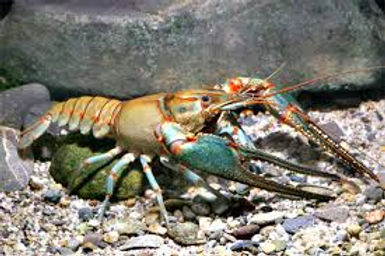Freshwater Crayfish :
This guide provides tips for keeping eight attractive freshwater crayfish species.
Introduction :
Crayfish can be very interesting aquarium inhabitants, but it is often difficult to identify a species or even find information about its requirements in captivity. Before learning about some possible aquarium crayfish, we need to cover the basics of these intriguing invertebrates.
Crayfish are found in a variety of habitats. Occasionally, they are found in brackish water, and some species can survive in saltwater for several days, but no marine habitats are permanent locations for crayfish. They are solitary animals that reside in dens or crevices, which they defend against intruding species members.
This aggressive behavior can change under certain conditions, however. For example, some species, such asOrconectes virilis, are passive when they molt or just before. In some species, too, aggression depends on temperature. A rising or falling temperature may be a spawning trigger, depending on the species, and then the aggression is proportional or inversely proportional with the rise in water temperature. The pH is not generally an important factor with captive specimens.
Fish That Can Be Kept With Crayfish:
With the small crayfish (such as Cambarellus), you can keep neon tetras, mollies, platies, swordtails and small catfish like Ancistrus.
With the bigger crayfish (like Cherax destructor), you can keep small fish as well as bigger fish like Aulonocaraand Pseudotropheus (Malawi and Tanganyika cichlid fish ), catfish like Ancistrus, Gibbiceps, South American cichlid fish, barbs, goldfish and labyrinth fish.
Normally the crayfish’s claws are too big and heavy to allow them to catch small, fast fish. One factor to keep in mind: When you buy a crayfish and put it in the tank, the fish will normally need about two or three days to get used to the fact that they are now sharing space with a creature that can catch them.
Crayfish are omnivorous. They eat plants and plant matter, detritus and wood, roots and, in many caves, bat guano. They are predators that hunt small invertebrates, such as snails, mussels, leeches and worms, and will eat their own kind on occasion. In the aquarium, they will eat all offered foods, including frozen red worms, snails, mussels, shrimp, krill and artemia; fresh carrots, corn and cucumbers (try nearly any vegetable); and all kinds of dried foods, such as flakes, wafers and tablets. They’ll sometimes eat fish and plants (frogs, too), but fish are seldom eaten because crayfish normally are not able to catch healthy animals. Injured, sick or recently killed fish and amphibians, however, are a welcome treat and eagerly eaten by crayfish.
Growth And Shell Replacement:
Crayfish have a flexible exoskeleton (its “shell”) that is repeatedly shed as the animal grows. When an old shell becomes too tight, the crayfish prepares to shed it. The entire process of developing a new, hardened shell may take days or weeks to complete, but the actual shedding may be finished in minutes.
A crayfish will stop eating three days to a week before a shed. It will be more active during the day and much more aggressive toward other crayfish. Increasingly dark, transparent edges show on the stomach and edges of the carapace. Immediately prior to shedding (or possibly a few hours before), these areas may break open.
During shedding, the crayfish will lie slightly on its side. First, the eyes and antennae are freed, followed by the claws and legs. Finally, the animal frees itself of the remaining shell on its tail by exerting some strong movements. Exhausted from the process, the crayfish now seeks shelter and rests.
The new shell is still soft and pliable, and during this time the crayfish is at the mercy of its enemies. It is now easy prey. The danger of crayfish cannibalism is not as great as is often assumed. If another crayfish comes too close, the newly shed animal will assume a defensive position, standing tall with closed claws raised high toward the approaching intruder.
Occasionally, crayfish are unable to free themselves of the old shell and die. It is also possible that some limb sections will break off in the process because they are stuck in the old shell. Difficult sheds such as this can result in weakened animals that are more susceptible to predators and intruders.
After several days the new shell hardens, and the crayfish is able to resume its normal life. The shed exoskeleton — a source of calcium — is typically eaten by its owner or other crayfish.
Prior to the shed, the crayfish absorbs calcium carbonate from its exoskeleton and secretes it to form white half-spheres called gastroliths (also known as “crayfish rocks”) in its stomach. During shedding, the gastroliths are dissolved in the stomach fluid, releasing calcium to harden the next exoskeleton.
Crayfish can regrow lost limbs over several sheds, and a regrown limb has full function. If a crayfish loses a limb shortly after a shed, it will be replaced immediately with a smaller, weaker one. Young crayfish that shed more frequently are able to regain functional, normal-size limbs faster than older or adult animals. For these latter crayfish, the claws may never reach their former size again.


Crayfish – The Care, Feeding and Breeding of Freshwater Crayfish (Crawfish):
Quick Stats :
Minimum Tank Size: 5 Gallons
Care Level: Easy
Water Conditions: PH 6.5-8 and Medium Hard to Very Hard
Temperature: 65-75 F (18-23 C)
Maximum Size: 3 inches (8 centimetres)
For anyone looking for a quirky and interesting pet, the freshwater crayfish is an excellent choice.. They are easy to care for, extremely hardy, and often interact with their owners. While crayfish are definitely not safe for a community fish tank, it is well worth having a tank dedicated to crayfish just to enjoy their antics.
When choosing a freshwater crayfish, it’s important to know that there are well over 100 species of crayfish from around the world. While most crayfish require cool water, some require tropical temperatures to thrive. Before purchasing a crayfish, a owner should do some research to determine the crayfish species needs. If a crayfish is well cared for, they will usually live 2-3 years, with some species living even longer.
Housing:
A single crayfish can be kept in a relatively small aquarium. A 5 to 10 gallon aquarium is usually more than adequate, especially if regular water changes are provided. Crayfish are notorious for hiding their food, and will often have a stash hidden away in a cave or flower-pot. On top of that, they are also messy eaters, and when coupled with hidden food , water quality can quickly decline. When doing water changes, you should always check for a stash of food in any of the crayfish hiding spots.
If more than one crayfish is going to be housed in a tank, then a minimum of 20 gallons need to be provided. Crayfish are cannibalistic by nature, and when a crayfish moults it is nearly defenseless until its shell hardens again. During this time, it will hide for a few days, so don’t be too alarmed if a crayfish disappears for a up to a week at a time. Because of this, it is very important to provide numerous hiding places and enough space for each crayfish in the aquarium – unless someone wants their crayfish to become an expensive meal for the other tank inhabitants.
It becomes much trickier when it comes to housing crayfish with fish. There are many accounts of people successfully keeping crayfish and fish together, but given enough time, either the fish or the crayfish is going to be eaten. There is nothing worse than losing a large, expensive fish to a crayfish over the course of a night. Or alternatively, finding crayfish parts scattered across an aquarium, with a very full looking fish. While a person can certainly try to keep fish and crayfish together, it ends badly more often than not.
The filtration for a crayfish should usually be a HOB (Hang-on-back) filter. While a sponge filter is cheaper than an HOB filter, the air line leading out of the tank gives the crayfish a perfect escape route. If you leave the crayfish alone long enough, you will eventually see a crayfish running around on the floor of your fish room.
Feeding:
A crayfish’s main diet should be comprised of sinking Shrimp Pellets, but they also enjoy some green vegetables and frozen foods in their diet. They are not picky when it comes to green vegetables and can be offered cabbage leafs, zucchini medallions and shelled peas. As for frozen foods, they happily accept small portions of frozen fish, daphnia, bloods worms and brine shrimp.
A word of warning – crayfish love aquatic plants and will eat any that are put in the tank with them. An adult crayfish can strip a heavily planted aquarium bare in a matter of days. So while it may be a good place to dispose of unwanted plant clippings, you should never put any plants in their aquarium that aren’t replaceable.
Breeding :
Most species of crayfish will breed at any time in the home aquarium, though feeding high quality foods and keeping the water pristine will help trigger breeding behavior. Crayfish can be frustratingly hard to sex for someone new to keeping them, but the easiest way is to look at the swimmerets. The males will have swimmerets that extend past the back legs, while the females won’t have any past the back legs.
When mating begins, the male deposits a sack of sperm on the female who then passes her eggs through the sperm to fertilize them. After the eggs have been fertilized, they are then kept under the tail by the female who should be placed in a tank on her own at this point.
After around four weeks, the eggs will hatch and the young crayfish will emerge. The female crayfish will take care of the young for a short period of time, but should be removed after a few days to prevent the fry from being eaten. A large nursery tank is required if any number of crayfish fry are expected to survive as they are extremely cannibalistic like their parents.
The baby crayfish can be feed blanched cabbage leafs or lettuce leaves, and also consume detritus in the tank. As the crayfish grow, the larger ones should be removed from the tank as they will feed voraciously on the smaller crayfish.
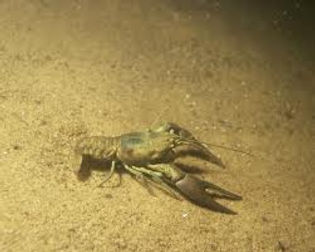
Crayfish Basics :
Many people associate crayfish with their youth. Mention the word “crayfish” and people respond with something like “oh ya, I used to catch them down at the creek when I was a kid”.
However the hobby of keeping crayfish in captivity has been rampantly growing in popularity among people of all ages. Being able to observe them in an aquarium fosters appreciation beyond the simple childhood curiosity. This is especially true in Japan and some European countries where they have been quite en vogue for decades. The United States usually plays catch-up with aquarium trends, and is following suit with its own crayfish craze. Crayfish are becoming more commonly seen for sale in aquarium stores and in Internet auctions and websites.
This gain in popularity comes at no surprise to the people that are familiar with crays. Once exposed to their interesting behaviors, individual personalities and attractive colors and patterns people often develop the extreme fascination that borders on obsession, similar to many other aquarium genres. I thought I would take a moment to write an article that covers the very basics of keeping crayfish. This should give all those people interested in becoming involved with crayfish a foundation on what it takes to do so.
Hopefully you will see that they are very easy to care for, which is one of the endearing qualities making them so popular.
Housing :
Crayfish are among the least demanding animals kept as pets, making them suitable for both children and adults. Compared to other aquatic and semi-aquatic animals, they only require the simplest living conditions, with filters and air pumps being optional extras rather than essential pieces of kit. That said, most people keep crayfish in a typical aquarium-type set up that includes a filter, and if you choose to keep your crayfish this way, so much the better. But at the bare minimum all you need for a crayfish enclosure is a small body of fresh water deep enough to cover the animal completely, and a rock or branch that allows it to climb out of the water (without being able to escape, of course!). Note that being able to climb out of the water is an essential requirement if the water is not aerated or filtered; crayfish need lots of oxygen, and in still water conditions, such as in a tank without a filter or airstone, they will get the oxygen they need from the air. But if they can’t climb out of the water easily, they will effectively drown.
Crayfish do not need to be kept a true aquarium, although this provides the best viewing of these creatures. The container can be as simple as a 5-gallon bucket or a plastic shoebox. Just make sure that the rim of whatever container you use is taller than the crayfish is long: they are amazing escape artists! If the container is not tall enough, they will probably need a vented lid to keep them contained. Crayfish are capable of climbing air hoses or anything else that extends high enough for them to reach the top.
Most crayfish burrow to some extent, whether a full-blown tunnel with complex chambers dug into the mud or simply a depression excavated underneath a submerged rock or branch. In captivity they will feel much more secure if given some type of cave within which they can reside. PVC tubes at least partially buried in the gravel are particularly welcomed by those crayfish species that build extensive burrows in the wild. Otherwise ceramic or plastic pipes cut in half lengthwise and placed on top of the substrate can be used for form shelters appreciated by most crayfish. Alternatively you can allow the crayfish to dig its own home by resting a large flat rock (like a slate) on top of several inches of gravel.
Having plenty of hiding places is especially important when attempting to keep more than one crayfish in a container. Some species are are fairly tolerant of one another provided they are not overcrowded, but others are very territorial and aggressive. Even the ones that are not aggressive toward each other most of the time may decide to attack and consume a tank mate who has recently molted. During the molting process the crayfish is weak and the body is soft and vulnerable, making it an easy meal for a hungry tankmate. Providing plenty of hiding places gives the molting crayfish a chance to escape attack during this dangerous time.
Ideally, you should remove a crayfish from its tank mates before the molting process begins and only replace it after the exoskeleton (‘shell’) has completely hardened and it is active and feeding normally. How will you know when a crayfish is getting ready to molt? Crayfish, like most other crustaceans, stop feeding shortly (usually at least a day or more) before shedding the old skeleton. If you notice that a crayfish in your collection is not eating, that could mean that it is about to molt and if maintained in a multi-specimen aquarium now would be a good time to isolate it from its tankmates. Of course loss of appetite can indicate other problems as well, so you should also check water quality and chemistry parameters and look for any signs of disease or physical damage.
Water Quality :
If no filtration is used, the water will have to be completely changed on a regular basis, at least once per week. If gravel is used in the tank it should be vacuumed or rinsed to remove excess detritus. Otherwise a bare bottom is fine to use and easy to keep clean. Ornaments and the sides of the tank should be left untouched to leave sufficient beneficial bacteria to keep the water adequately clean. If you detect ammonia or nitrite in the water at any time that means that there aren’t enough bacteria in the tank as it is, and adding a filter will be useful.
Undergravel filters are not the best choice for crayfish since these burrowing animals will move the gravel about creating exposed areas of the filter plate dramatically reduces the efficiency of this type of filter. Internal or external canister filters as well as hang-on-the-back filters that provide for biological filtration are a much better choice. Air-powered sponge filters also work great but I have found that some species like to chew on them. This never seemed to harm the crayfish, but the filter will have to be replaced after they have shaved it down sufficiently. The possibility of their digestive tract becoming impacted from the indigestible sponge material should not be completely ignored, but I have never seen any evidence of this hypothetical problem.
[Editor’s note: like Justin, I’ve also noticed that large crustaceans such as crabs enjoy picking away at sponges. Most likely they consume the organic matter trapped in the sponge and discard the actual sponge material itself. Even if they do eat some of the sponge, I agree with Justin that this doesn’t seem to cause them any harm.]
Temperature :
Crayfish come from both temperate and tropical zones, and water temperature will depend upon which species you are keeping. A heater is not required and should not be used in tanks holding most of the North American species, though species from the southern United States can tolerate temperatures as high as 82 degrees F (28 degrees C) without problems. Two very popular North American species are Procambarus alleni and Procambarus clarkii, both of which are species from the southern US. Colorful varieties are grown in large numbers in ponds specifically for the aquarium industry.
But other North American species are showing up in the trade, albeit on a much smaller scale, and in the case of these less frequently seen crayfish you should make sure you know where they come from so that you can maintain them at an appropriate temperature. As a general rule though, erring on the side of keeping North American species too cool is better than keeping them too warm, and most do well left at room temperature.
Australian species are increasingly popular, and most of those require tropical temperatures around 77 degrees F (25 degrees C).
[Editor’s note: In the United Kingdom, it is illegal to keep coldwater crayfish in home aquaria without a specific license. This is because at least one North American species has become widely established in British rivers, and by spreading a crayfish plague has lead to the virtual extinction of the native crayfish. Any crayfish legally sold in a British tropical fish shop will be tropical species from Australia, and consequently must be kept in a heated aquarium.]
Feeding :
Crayfish are omnivorous scavengers, feeding primarily on plants, algae and organic detritus. Crayfish do not often find sources of animal protein such as a dead fish, and such meals are very precious to them, aggressively defending such a meal against other scavengers.
But will crayfish actually kill and eat your fish? In an aquarium it is uncommon for crayfish to catch and eat healthy fish, though the odds on such an event depend on the size of aquarium, the number of fish in the aquarium, what species of crayfish is being kept, and even whether the crayfish is well fed or not. So while it is unlikely that a crayfish will catch your fish, there is a possibility, particularly where small or slow moving fish are concerned. Most of the time crayfish are seen eating a fish that fish was already dead or dying, and the crayfish was simply doing its natural duty of being a scavenger. Without knowing this, the aquarist might falsely accuse the crayfish of murder when he notices the crayfish chewing on the carcass!
Crayfish need to be fed a small amount of food every other day or so. Any excess food should be immediately removed. Foods to feed your crayfish include leafy green vegetables such as Romaine lettuce (or other varieties); dried seaweed like Nori; sinking pellet foods such as shrimp or algae pellets; flake food; and freeze dried or frozen foods such as fish, krill, tubifex worms, bloodworms, squid, clam, etc. Since animal protein is rarely encountered in the wild, it is best to feed crayfish mostly plant or algae based foods, and only supplement with animal flesh. However, some aquarists feed strictly shrimp pellets with no apparent problems.
If a crayfish remains soft for an extended period of time, i.e., for more than one day after molting, this can mean that it is not receiving enough calcium in its diet or that the pH or hardness of the water is too low. Transferring the soft specimen to water with high hardness can help if this is the problem, but it is best to avoid this problem by keeping crayfish in hard water and feeding them foods rich in calcium. There are some brands of foods specifically formulated for crustaceans that have a higher level of calcium added, such as JBL NovoCrabs Food Chips and Sera Crabs Natural Complete Diet. Calcium can also be added to other foods by dabbing moist food with a small amount of calcium carbonate powder before feeding your cray.
Crayfish sometimes die during the moulting process, a problem apparently caused by an iodine deficiency. Iodine, in the form of potassium iodide, can be added to the water on a weekly basis to alleviate problems with the molting process. Iodine drops sold for use in marine tanks work well for this, though a half dose rather than full dosage is all that is required. Foods that contain the algae Spirulina sp. or Chlorella sp. are naturally high in iodine and can be helpful as well.

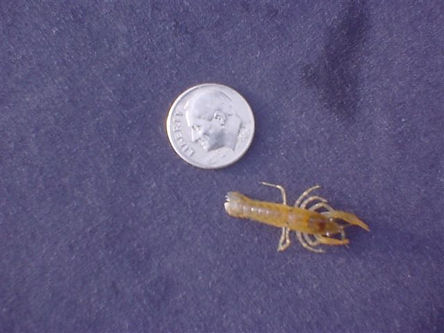
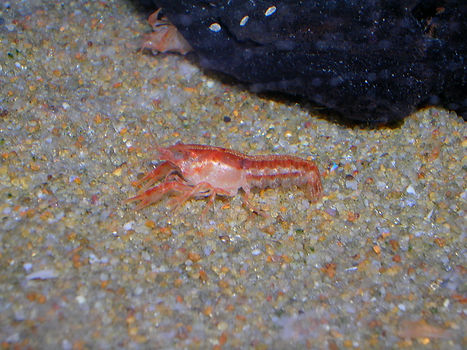
Disease :
It is a very bad idea to mix together crayfish from different continents. While there is a risk of spreading disease when crayfish are placed in the same tank as another one, one disease in particular poses a very great threat. Known as the Crayfish Plague it is carried by North American crayfish species. It is a fungus, Aphanomyces astaci, and American crayfish have apparently evolved to tolerate the fungus without much problem. However, it is lethal to many other types of crayfish, including those from Australia and Eurasia.
Never place any crayfish native to another continent together with those from North America. In addition, be very careful not to share any equipment such as nets or buckets when working with North American and non-North American species. The same precautions hold for gravel, pipes and other decorations.
Another disease that can threaten crayfish is White Spot Disease. This is primarily a disease that effects shrimps, but may be transmittable to crayfish if they are fed with raw food made from infected shrimp. Be sure that any food containing shrimp has been cooked in order to destroy the virus.
If you intend to keep multiple crayfish specimens in a single aquarium, be sure to quarantine all new crayfish specimens for at least a month before adding it to the main aquarium. That said, realize that crayfish diseases are often difficult to recognize and even more difficult to treat.
A final and very important comment!
Do not ever release any crayfish maintained in captivity into the wild. Also make sure that there is no possible way for the crayfish to escape into the wild; this is particularly an issue when keeping crayfish in ponds or outdoor fish houses.
Crayfish can disrupt entire ecosystems if they are introduced into areas where they are not native, as has been the case in many parts of the US and UK. Some US States have begun imposing regulations on the transport of crayfish for this reason, and in other parts of the world there may be restrictions on what crayfish can be legally sold as pets. Even if you think that a particular crayfish is native to your area, there is still the risk of introducing diseases into the wild crayfish population.
Many crayfish are only found in specific microhabitats within larger bodies of water. So even if they are native to your general area, you may be placing them in inappropriate waterway in that area. Furthermore, while there are many crayfish species with very wide distributions in a general sense, in terms of genetics and morphology there may be very distinct populations of crayfish within certain areas. It’s likely some of these populations may end up being recognized as distinct races, subspecies or even new species, so let’s make sure the genetics of different populations stay in their natural state so that researchers can get this issue straitened out!
Crayfish can make fascinating pets, but please be responsible and ensure that your crayfish stays contained. Any unwanted crayfish should be humanely euthanized or given to a responsible person who understands this issue and will house or destroy the crayfish as required.
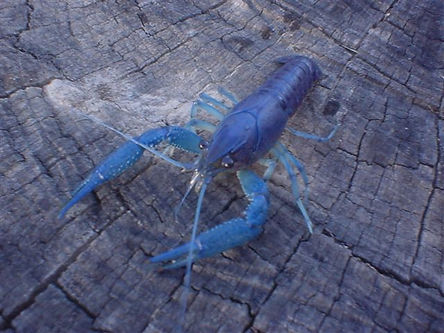
Crayfish and Lobsters species :
Crayfish and lobsters can be found in a variety of cooler waters, and there have been some problems with crayfish making an overpowering appearance outside of their native waters. For that reason certain species can be hard to find in aquatics centres, and you may need a licence to keep non-native specimens. All varieties sport glorious colours, they are however best kept in a specimen or species aquarium. Their aquarium should be furnished with rocks and plastic plants and roots as real plants will be destroyed. If more than one crayfish is to be kept in a tank they will need a lot of space as they are both territorial and cannibalistic. Also after a cray has moulted it becomes very vulnerable, if it is kept with anything that may attack it (like another crayfish) then the cray should be removed/separated until the carapace hardens. Crayfish are nocturnal and are best viewed after lights out, they should also be fed around lights out until they adopt a diurnal existence. They will readily hand feed once settled. Feed an omnivorous diet, including shrimp pellets, small fish, lean meats, worms, cockles and other frozen foods. Any uneaten food should be removed quite quickly as they have a tendency to hide hoards of food.
- Crayfish from Europe and Asia :
- Crayfish from the Americas :
- Crayfish from Australia
- Crayfish from Europe and Asia :
1- Sci: Astacus leptodactylus
Common: Galician Crayfish
Origin:East Europe
Size: 12 cm
Temp: 8 - 22 C
Breeding details :
In the more evolved form of reproduction, the fry are usually born as miniature versions of the adults. Usually limited to crayfish and shrimp, it is also found in some species of crabs; namely the Potamon family of land crabs.
The larvae will hatch after up to 28, days and the young are almost fully-formed within the eggs during this time. Once born the only anatomical feature not present is the reproductive organs.
They eat almost the same food as the parents (just scaled down in size), and will develop and grow very quickly.
They are usually fairly easy to breed under aquarium conditions, and will be cared for by their mother until released (when some cannibalism may occur).
As the more specialised fry have a much better survival rate than the primitive fry, the females produce fewer eggs (from only 7 up to 300 depending on species and condition) making the numbers more manageable.
The most important stage of their development is their first 24 hour period, during this time the fry will undergo their first moult, and many will not survive. Only the fry that survive the first two weeks have a good change of reaching adulthood.
The water should be changed frequently during this period, and quality needs to be kept good to assure a higher survival rate.
Some species, like the long-arm shrimp, will be born as floating larvae, and will only start crawling after this period. These species need to be fed small live feeds such as newly hatched brine shrimp or microworms, or Liquifry type foods, but care should be taken to ensure the water doesn't become too polluted.
The juveniles will look very different in colour to the parents, usually appearing transparent and well camouflaged. Their colours will change only when they reach sexual maturity, and start to attract a mate. Some species, especially crayfish, may predate on their smaller siblings too, so you may need to segregate them as they grow.
The mating process is rarely witnessed, the only evidence that it has happened is the eggs held within the females pleopods.
During the ritual, the males will attract (or entrap) a female, and they will copulate in the 'Y' position for a short time, continually cleaning and preening each other throughout.
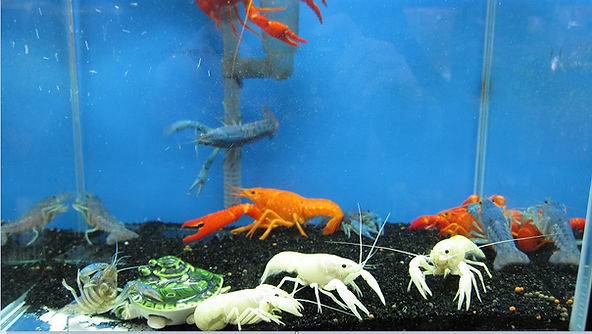

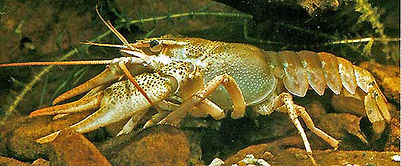
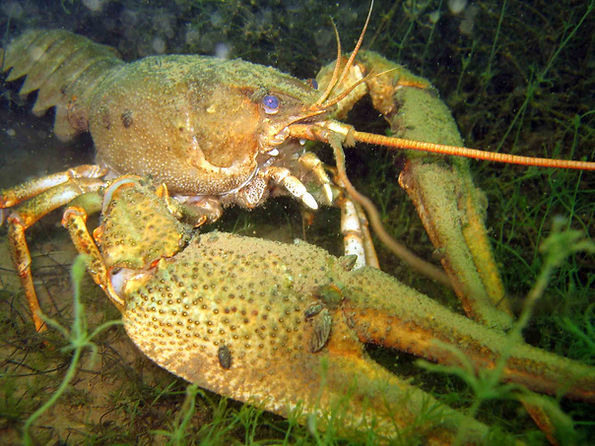
2-Sci:Austropotamobius pallipes
Common:White Claw Crayfish
Origin:Europe (Endangered in UK)
Size: 12 cm
Temp:8-22C
Breeding details : Same as Astacus leptodactylus

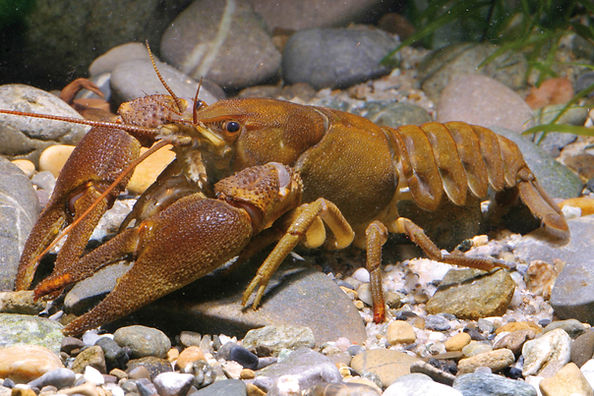
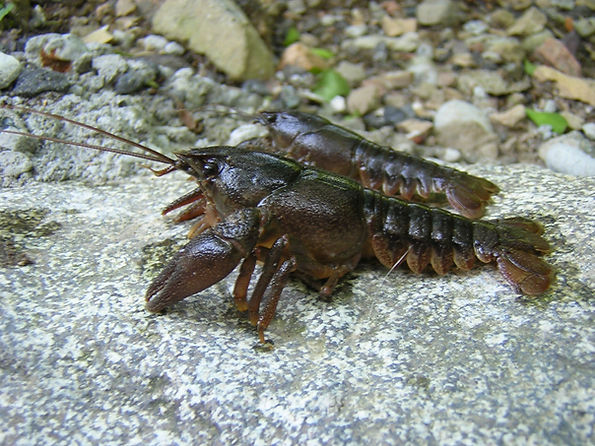
- Crayfish from the Americas :
1- Sci:Aegla sp.
Common:Red Cave Crayfish
Origin:Mexico
Size:8cm
Temp:22-24 C
Breeding details : Same Astacus leptodactylus
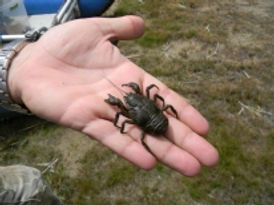


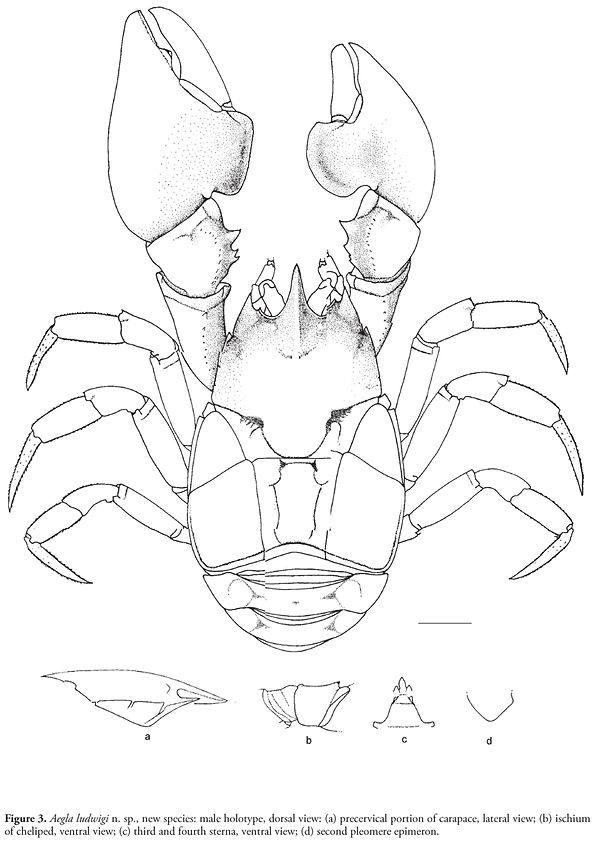

2- Aegla sp. argentina
"Neither Crab nor Crayfish". Apart from shrimp, crabs, and crayfish, another member of the crustaceans has once began to invade the freshwater invertebrate hobby. Aegla are part of a family of mainly marine crustaceans, of which hermit crabs probably are the most well known. I like the little imps very much because of their unusual looks and the fact that they do breed readily in the aquarium. Lets hope that they can reach a wider distribution in the hobby and that other species do get available in the future.
Origin and Background:
There are more than 100 Aegla species of many colors and many different in shapes throughout South and Central America . For example there are some in blue and orange, while others have huge pincers, almost as big as the body. However, of this diversity only one species is available to the hobby as no others have been commercially imported and/or established. It is a species of average looks, with a brown-golden to blueish-grey body. Its origin is said to be Argentina, but the exact species is not known.
Appearance:
Only 4 of 5 pairs of legs that make up a decapod are visible. 3 pairs of walking legs and one pair of pincers. The 5th pair of legs is reduced and is situated under the tail, which is turned around, like that of a crab. It is used for caring for and cleaning the brood only. Aegla sp. Argentina gets about 4 cm in diameter of the body, males can get slightly larger. One can tell apart males from females by the stronger pincers, males have and by the location of the gonopores. Only females do have gonopores, that look like little holes, on the third pair of walking legs. Sometimes one can see the eggs being produced currently in the ovaria shining through the translucent body, under the tail. Photo below showing adult specimen.
Tank Requirements:
I keep my Aegla like any other invertebrates I keep at tap water, pH 7,8 GH 12 and temperature around 20-22°C (68F-72F). Due to the fact that I keep my tanks in the basement, it does not get very warm there in summer and therefore I do not use heaters. Other people reported that Aegla do not like very hot temperature, roughly anything above 25°C (77F). If it does get hot in your Aegla tank in summer, make sure that at least enough oxygen is dissolved in the water. A lack of oxygen seems to be the main problem for any aquatic animal which are exposed to higher temperature than usual. Aegla seem to like hiding during the day and wandering around and looking for food at night. You can make them more visible by placing their hiding spots at a place you can easily observe. Bricks do make excellent caves for them.
Breeding:
I have never witnessed Aegla mating so I cannot tell anything about courtship rituals. However, the females do get berried. They can only have young 2-3 times a year in captivity due to the long time the eggs take to develop. Estimated egg number is about 50 to 100 depending on the size of the female. It takes about 6 weeks until the eggs, which are orange colored in the Aegla sp. Argentina species, turn into little Aegla that do look exactly like their parents and are only 1mm in size at first. Aegla do not seem to feed on their young, so you can leave them with their parents. The young do molt very often at first and you can see them grow with every molt. It takes about half a year until they reach maturity. I am currently raising the second generation. Photos below of various breeding stages.
Feeding :
Aegla do feed on anything a crayfish would eat, too. Normal fish food, leaf litter, detrius etc. They do like eating small snails, like ramshorn snails. Keeping them with adult apple snails does seem safe. I would not recommend mixing with crayfish of any kind, as I have no information whether that works or what doesn't. Mixing with shrimp is safe, as they do not seem to be interested in catching shrimp and are way too slow to catch them anyway. The same is true for peaceful fish, like guppys or tetras. Be cautious however with bottom dwelling fish, I do know that they can be kept with Ancistrus, but I did not try others.
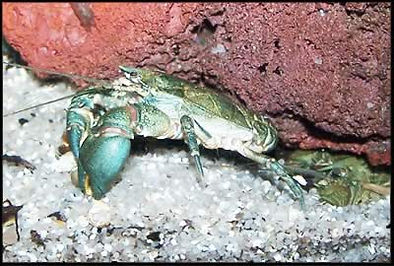

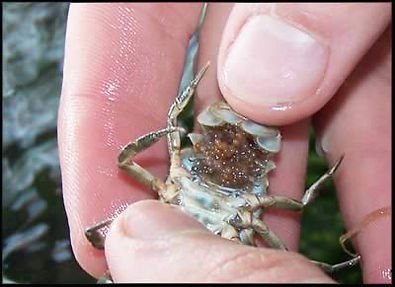


Genus Cambarellus
3-Sci:Cambarellus latimanus
Common:-
Origin:-
Size:3-4 cm
Temp:22-24 C
Breeding details :


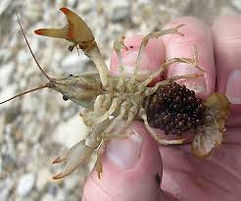
4- Sci:Cambarellus maculatus
Common:Freckled Crayfish
Origin:-
Size:14 cm
Temp:22-24 C
Breeding details
5- Sci:Cambarellus montezumae montezumae
Common: -
Origin:Lago Salazar Mexico
Size:15cm
Temp: 22-24°C (72-75°F)
Ph: 7.8
GH: 12-15
I essentially use tap water to breed them.
Genetics: It will interbreed/can breed with other Cambarellus species like patzcuarensis, puer, shufeldtti, etc.
A cousin of the Cambarellus patzcuarensis, this is another dwarf crayfish which originates from Mexico. They can be molted or striped. In the strain I have, all adults look like the one in the picture. During the first few months after birth, most of the babies exhibit a very light colored brown color until they start developing the molted pattern. I have had this crayfish for around a year and a half. I currently have around 50 individuals from three different generations. As far as I know, I am the only one currently breeding this crayfish in the USA.


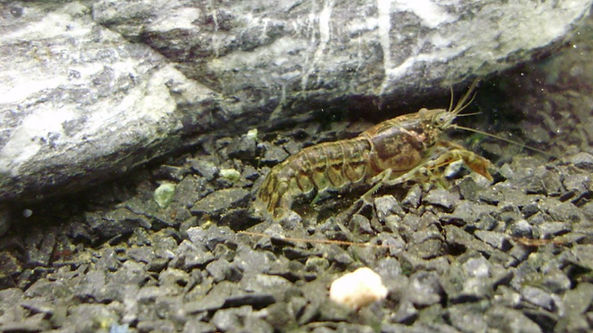
6-Sci:Cambarellus schmitti
Common:
Origin:
Size:
Temp:22-24 C

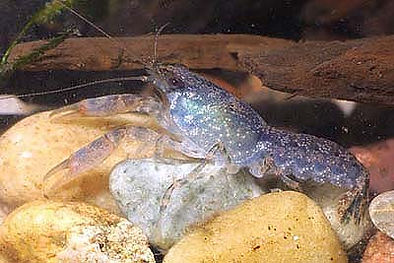
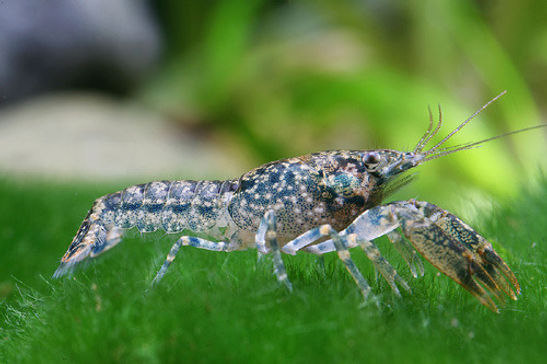
Cambarellus schmitti mating
7- Sci:Cambarellus shuffeldtii
Common:Mississippi Dwarf Crayfish
Origin:Mississippi
Size:2-4cm
Temp:22-24 C
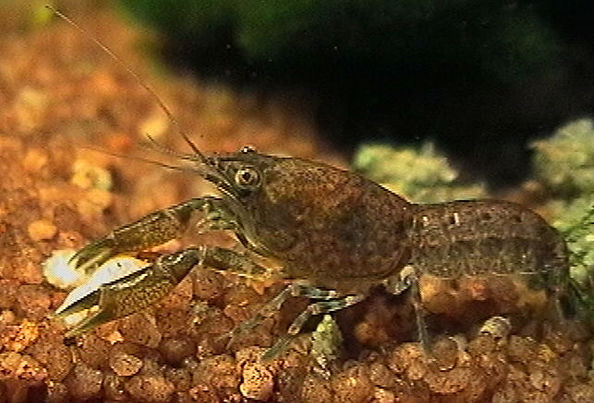

8-Sci:Cambarellus zempoalensis
Common:-
Origin:Mexico
Size:20 cm
Temp:22-24 C

9- Cambarellus patzcuarensis
Information by Milalic :
The water parameters for this species is as follows:
Temp: 22-24°C (72-75°F)
Ph: 7.8
GH: 12-15
I essentially use tap water to breed them.
Genetics: It will/can interbreed with other Cambarellus species like montezumae, puer, shufeldtti, etc.
This outstanding looking crayfish is commonly known as orange dwarf cray. It can show different varieties of tones of orange. They can be molted or striped. They are commonly just called CPO's. Cambarellus patzcuarensis sp. Orange was selectively bred by Juan Carlos Merino in the Netherlands and first sold in Germany from the wild form of the Cambarellus patzcuarensis which is from Mexico. I have had the Cambarellus patzcuarensis sp. Orange for around a year now. Recently I have been able to breed them and am currently on my fourth batch at the moment. Many people keep this crayfish with their shrimp with great success, but there have been a few reports of them eating a shrimp. I believe most of them were probably sick shrimp anyways, but keep in mind that it could happen


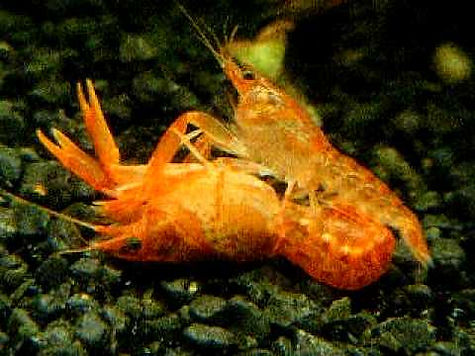
Genus Cambarus :
10- Sci:Cambarus diogenes
Common:Devil crayfish
Origin:-
Size:20cm
Temp:22-24 C
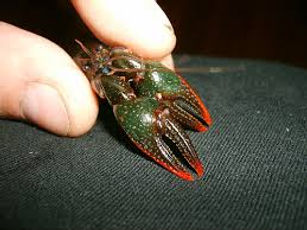

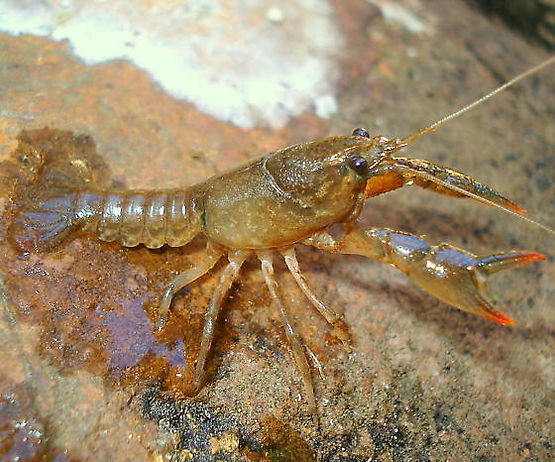
11-Sci : Cambarus geodytes
Common:
Origin:
Size:15cm
Temp: 22-24 C

Genus Orconectes
12-Sci:Orconectes immunis
Common:Nail Polish Crayfish
Origin:-
Size:14cm
Temp:10-22C
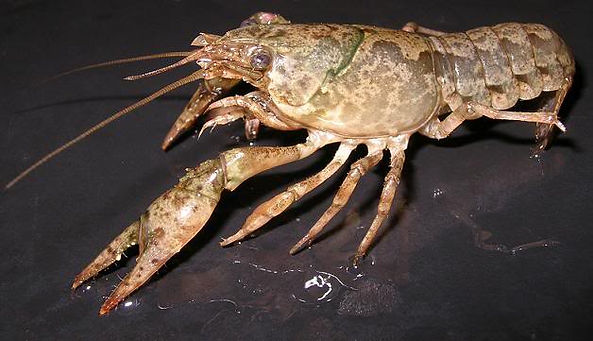

13-Sci:Orconectes limosus
Common:Camber Crayfish
Origin:North America
Size:12cm
Temp:22-24 C
Word of Caution on Aquarium Crayfish!
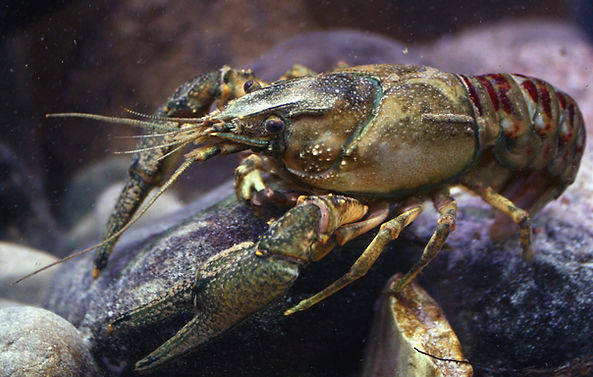

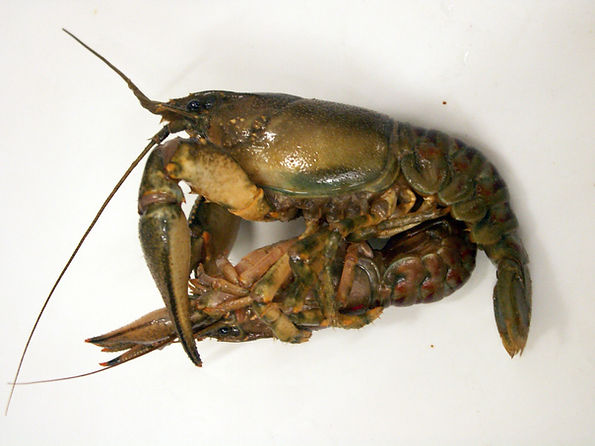
14-Sci:Orconectes longidigitus
Common:Long-Pincered Crayfish
Origin:
Size:16cm
Temp:22-24C
